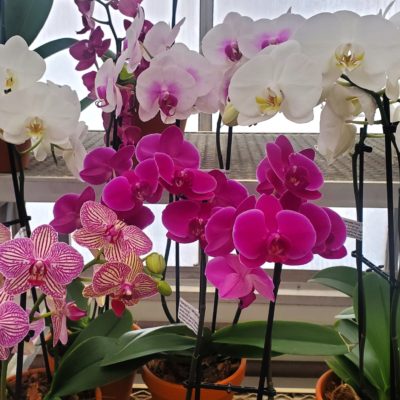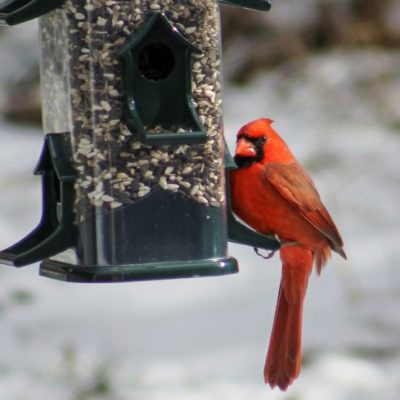
Perennial Plant Profile: Hardy Grasses
Perennial Grasses, or Hardy Grasses, are a fantastic choice for any garden because of their durability and hardiness to our cold winters but also for their incredibly diverse range of heights and textures. You can line your walkway with adorable Blue Fescue (Festuca) or add three seasons of height and visual interest with Karl Foerster (Calamagrostis); you can even hide your neighbours’ yards from view with 10-foot bamboo-like Miscanthus Giganteus! There’s just something magical when you see grass swaying in the wind – it’s like your garden is waving hello! There are a lot of options out there, and we carry many of them in our Perennial Centre from spring to fall*.
*Please note: Our availability changes constantly and quickly; all varieties may not be available at all times.
A Grass for Every Space
Shady Spots: Hakonechloa (Japanese Forest Grass), Chasmanthium (Northern Sea Oats).
Sunny Spots: Everything else! All varieties of Calamagrostis (Feather Reed Grass), Miscanthus (Maiden Grass/Silver Grass), Festuca (Blue Fescue), Imperata (Japanese Blood Grass), Panicum (Switch Grass), Helictotrichon (Blue Oat Grass).
Wet/Boggy Areas: Chasmanthium, Deschampsia (Tufted Hair Grass), Miscanthus.
Drought Tolerant: Most varieties once they’re established, which can take at least one full year or more depending on the variety.
Colourful Foliage: Andropogon (Bluestem), Festuca (Blue Fescue), Helictotrichon (Blue Oat Grass), Imperata (Japanese Blood Grass), Miscanthus ‘purpurascens’ (Flame Grass), Panicum (Switch Grass).
Fall/Winter Interest: Most Perennial Grasses can be left as they are through the winter (their foliage looks almost magical when covered with frost). Bonus: varieties that grow taller than the snow drifts can provide shelter and, in some cases, food for non-migrating birds.
From Low to Whoa!
Short varieties (up to 24”) are great for edging, borders, and mass planting: Festuca (Fescue), and Imperata (Japanese Blood Grass).
Medium Height (24” to 60”) varieties add height, texture, and movement as they sway in the wind: Andropogon (Bluestem), Chasmanthium (Northern Sea Oats), Calamagrostis (Feather Reed Grass), Deschampsia (Hair Grass), Hakonechloa (Japanese Forest Grass), Helictotrichon (Blue Oat Grass), Miscanthus ‘Purpurascens’ (Flame Grass), Panicum (Switch Grass).
Tall varieties (60” and up) are all about that “wow” factor! Put them at the back of your garden beds and borders for incredible visual interest, or plant along your property line for natural privacy screening: Miscanthus – all varieties range from 5 to 7 feet tall but ‘Giganteus’ (Giant Silver Grass) will reach heights of 10 feet! Panicum ‘Strictum’ grows up to 6 feet.
Basic Care for Your Perennial Grass
Read the individual plant tag for the variety’s sun and soil preferences; your Calamagrostis won’t appreciate being in the shade of a large cedar hedge.
Dig a hole that’s slightly deeper and wider than its current pot, and add some compost, composted manure, or 3/1 mix to boost your soil’s nutrient levels; you can also add a handful of perennial fertilizer into the hole for a quick initial feeding for their root system. Place your grass into the hole, ensuring the soil level is consistent from old pot to new home, then fill in with soil and pat down gently to secure the crown.
Water your new garden additions deeply and regularly for their first year, especially during hot summer weather. This will help those roots to grow deep, which will help them find water in later years (you’ll still need to water them deeply during summer droughts).
Perennial grasses are light feeders, so you really don’t need to fertilize beyond that first dose at planting. A handful of bone meal in the spring and/or a top dressing of compost/composted manure is all they’ll need.
Cut your grasses back in either late fall or early spring. We like to leave our perennial Grasses as they are through the winter to add some height and texture to the horizon; they also provide shelter and even food to non-migrating birds. If you choose to wait until spring, make sure to cut them back before any new growth appears. Note: you may need hedge trimmers to get through Giganteus’ thick stalks!
Like most perennials, it will take an average of 3 years before your perennial grass is fully mature and reaches its full height and spread. Year 1 is all about getting the roots established, hence the regular watering, so expect to see more growth in second and third years and beyond!
The best time to divide most mature (3 years or older) perennial grasses is in early spring.





